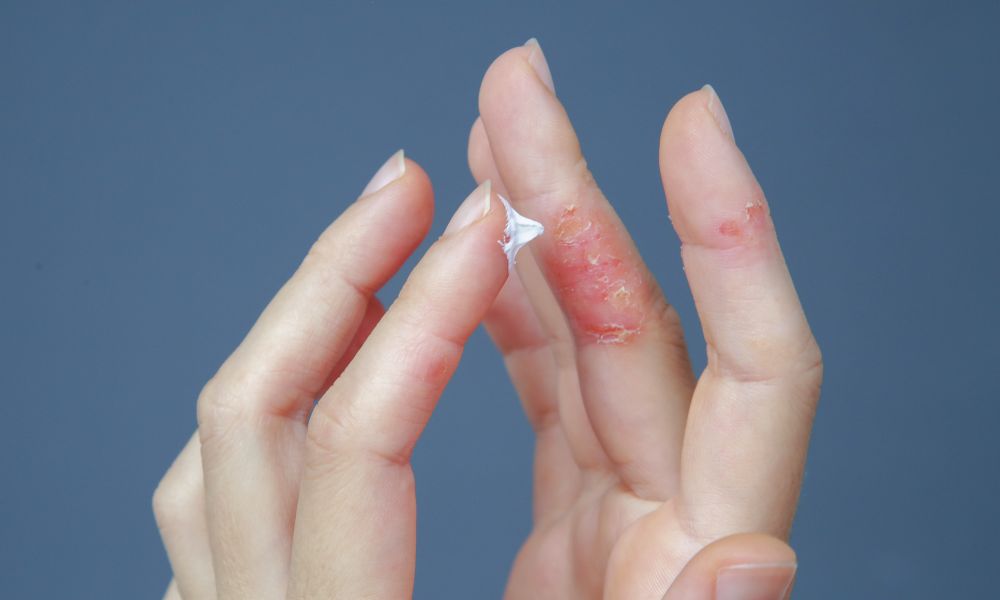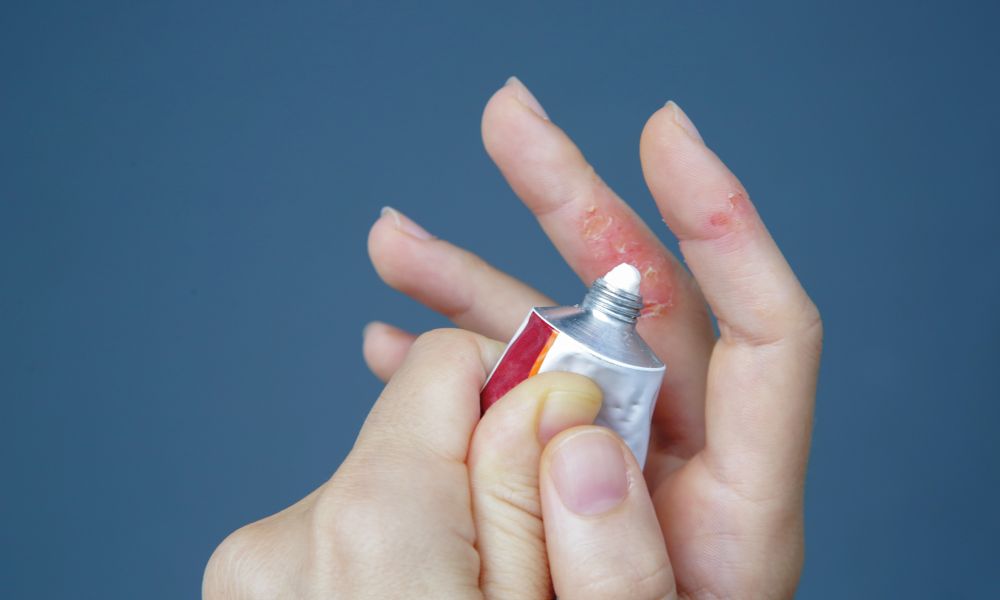Table of Contents
You’re not alone! But don’t worry, relief is within reach. In this guide, we’ll dive deep into proven methods to treat dyshidrotic eczema on your hands and soothe your irritated skin.
Tired of waking up to itchy, blistered hands? You might be facing dyshidrotic eczema, a common skin condition that can leave you feeling frustrated and isolated. But fear not, fellow sufferers! This article cracks the code of tiny blisters, giving you the knowledge and tools to manage your eczema effectively.
I. What is Dyshidrotic Eczema?
Dyshidrotic eczema, also known as pompholyx, is a chronic inflammatory skin condition that primarily affects the palms of your hands and the soles of your feet. It manifests as tiny, deep-seated blisters that often appear in clusters, causing intense itching and burning. While not contagious, it can significantly impact your daily life.
Symptoms & Appearance:
Be on the lookout for these telltale signs of dyshidrotic eczema:
- Tiny, deep-seated blisters: The hallmark symptom, usually appearing on the sides of fingers, palms, and soles.
- Intense itching & burning: Blisters can be unbearably itchy and sometimes burning.
- Dry, cracked skin: As blisters heal, the area becomes dry and cracked, worsening discomfort.
- Redness & swelling: Inflammation can cause redness and swelling in the affected area.

Causes & Triggers:
The exact cause remains a mystery, but potential culprits include:
- Genetics: Family history of eczema increases your risk.
- Allergies: Allergies to metals, nickel, cobalt, or even seasonal allergies can trigger flare-ups.
- Stress: Feeling stressed can worsen symptoms.
- Sweaty hands & feet: Frequent sweating creates a moist environment favoring eczema.
- Irritants: Harsh soaps, detergents, and cleaners can irritate and trigger flare-ups.
- Medical conditions: Certain medical conditions, like thyroid problems, can be associated with it.
Who is Affected?
Dyshidrotic eczema typically affects young adults (20-40) but can occur at any age. It’s also more common in women.
While anyone can develop dyshidrotic eczema, certain groups are more likely to experience this frustrating skin condition. Here’s a breakdown of those most commonly affected:
Age:
- Most prevalent: Young adults between the ages of 20 and 40.
- Can occur: At any age, including childhood and later in life.
Gender:
- More common: In women, with a ratio of around 2:1 compared to men.
- Not exclusive: Men can still be affected, and the reasons for the gender disparity are not fully understood.
Family history:
- Increased risk: If you have a close family member with eczema, atopic dermatitis, or dyshidrotic eczema, you’re more likely to develop it yourself.
- Genetics play a role: While the exact genes involved are still being researched, a genetic predisposition seems to contribute to the development of dyshidrotic eczema.
Other factors:
- Allergies: Individuals with allergies to metals like nickel or cobalt, or those with seasonal allergies, might be more prone to flare-ups.
- Sweaty hands and feet: Occupations or activities that lead to frequent sweating in these areas can create a favorable environment for the development of eczema.
- Stress: Periods of heightened stress can trigger or worsen eczema symptoms.
- Certain medical conditions: Some medical conditions, such as thyroid disorders, can be associated with dyshidrotic eczema.
Remember:
Even if you don’t fall into any of these categories, you can still develop dyshidrotic eczema. Consulting a dermatologist for diagnosis and personalized treatment is crucial for managing the condition effectively.

II. Home Care and Self-Management:
Daily skincare routine
Living with dyshidrotic eczema can feel like a constant battle against tiny, itchy bubbles. But fear not! By incorporating some simple yet effective home care and self-management techniques, you can significantly improve your comfort and reduce the impact of flare-ups. Let’s explore your daily toolkit for calmer, happier hands:
1. Gentle Cleansing and Drying:
Think of your hands as delicate treasures. Ditch harsh soaps and opt for fragrance-free, gentle cleansers specifically formulated for sensitive skin. Avoid hot water, as it can strip your skin’s natural oils, and pat your hands dry instead of rubbing with a towel. Remember, moisture is your friend!
2. Moisturizing: Your Secret Weapon:
Moisturizing regularly is a cornerstone of managing dyshidrotic eczema. Look for fragrance-free, oil-based moisturizers that lock in hydration. Apply them frequently throughout the day, especially after washing your hands. Consider thicker ointments for nighttime to maximize their soothing effect. Experiment with different brands and textures to find your holy grail moisturizer.
3. Avoiding Irritants and Triggers:
Become a detective! Identify substances that exacerbate your eczema and minimize contact with them. This might include harsh chemicals, certain metals, or even specific laundry detergents. Pay attention to seasonal allergies and triggers that might worsen your symptoms.
4. Soaking and Compresses: Cooling Relief:
When the itch becomes unbearable, seek solace in cool soaks. Prepare a lukewarm bath with oatmeal or baking soda, or use cool compresses on affected areas. This can reduce inflammation and provide temporary relief. Remember to moisturize afterwards to prevent further dryness.
5. Stress Management: Calm Your Mind, Soothe Your Skin:
Stress can be a sneaky trigger for eczema flare-ups. Incorporate stress-busting techniques into your daily routine, such as deep breathing exercises, meditation, or yoga. Consider activities you enjoy, whether it’s reading, spending time in nature, or listening to calming music. Taking care of your mental well-being can positively impact your skin health.
6. Keeping Fingernails Short and Clean:
Long nails can harbor bacteria and worsen itching. Keep your nails clean and trimmed short to minimize the risk of scratching and further irritating the affected area.
Every individual’s skin is unique, and what works for one person might not work for another. Consult your dermatologist for personalized recommendations and don’t hesitate to experiment to find the self-care strategies that bring you the most relief. Stay tuned for the next chapter, where we’ll delve into medical treatments and additional resources to empower you on your journey to healthier, happier hands!
III. Medical Treatments:
While self-care is crucial in managing dyshidrotic eczema, sometimes you need an extra arsenal in your fight against tiny blisters. That’s where medical treatments come in. Let’s explore some options your doctor might suggest:
1. Topical Corticosteroids: The First Line of Defense:
These creams and ointments are often the first-line treatment for mild to moderate eczema. They help reduce inflammation and itching by suppressing the immune system’s response. Different types are available, ranging from mild to potent, and your doctor will choose the best one based on your needs. Side effects can include thinning of the skin, so proper application and follow-up are crucial.
2. Calcineurin Inhibitors: Joining the Fight:
If corticosteroids aren’t enough, calcineurin inhibitors like tacrolimus and pimecrolimus might be considered. These work by suppressing specific immune cells involved in the inflammatory process. They tend to be less potent than corticosteroids but have a different side effect profile, making them suitable for long-term use or sensitive areas.
3. Oral Corticosteroids: A Powerful Weapon, Used with Caution:
Due to their strong side effects, oral corticosteroids are reserved for severe cases or when other treatments haven’t provided relief. These medications suppress the entire immune system, so their use requires careful monitoring and is typically short-term.
4. Antihistamines: Calming the Itch Storm:
Antihistamines can help manage the itch, especially at night. However, they don’t address the underlying inflammation, so use them in conjunction with other treatments.
5. Anti-Fungal Medications: Addressing Hidden Culprits:
In some cases, fungal infections can trigger or worsen eczema. If your doctor suspects this, they might prescribe anti-fungal medications to eliminate the underlying issue.
6. Draining Large Blisters: Seeking Relief for Big Bubbles:
For particularly large and painful blisters, your doctor might suggest draining them in a sterile environment to reduce discomfort and promote healing. However, this should only be done by a professional to avoid infection.
7. Emerging Therapies: A Glimpse into the Future:
Research is constantly exploring new and improved treatments for eczema. Stay tuned for exciting developments like biologics that target specific immune pathways and other innovative options on the horizon.
Remember: This information is for educational purposes only and does not constitute medical advice. Always consult with your doctor to discuss the best treatment options for your individual case.
IV. Additional Support and Resources:
Dyshidrotic eczema can be a challenging journey, and navigating it alone isn’t necessary. This section highlights valuable resources and support systems to empower you beyond medical treatments:
1. Finding Your Eczema Champion: The Dermatologist:
Seek out a dermatologist with expertise in eczema, especially dyshidrotic eczema. They can provide personalized treatment plans, address specific concerns, and offer ongoing support throughout your journey.
2. Joining the Tribe: Patient Support Groups and Online Communities:
Feeling isolated with your eczema struggles? Connect with others who understand! Patient support groups, both online and in-person, offer a safe space to share experiences, ask questions, and find encouragement. Platforms like the National Eczema Association (NEA) or online forums can be invaluable resources.
3. Taming the Emotional Rollercoaster: Managing Psychosocial Impact:
Living with a chronic skin condition can take a toll on your emotional well-being. Don’t shy away from addressing the psychological and social impact of eczema. Talk to your doctor about potential support options, such as therapy or counseling, to help manage stress, anxiety, and other related challenges.
4. Unlocking the Future: Resources for Research and Clinical Trials:
Staying informed about new research and clinical trials can offer hope and a sense of empowerment. Organizations like the NEA or the American Academy of Dermatology (AAD) provide resources and information about ongoing research efforts. Participating in clinical trials can be a way to contribute to advancements in eczema treatment and potentially access new therapies.
Remember: You are not alone on this journey. By building a strong support system, utilizing available resources, and actively managing your well-being, you can empower yourself to navigate dyshidrotic eczema with confidence and find moments of joy in your daily life.
V. Conclusion
Living with dyshidrotic eczema can feel like an uphill battle, but remember, you’re not alone. By understanding the condition, incorporating self-care strategies, exploring medical treatments, and building a strong support system, you can significantly manage your symptoms and reclaim control of your well-being.
Embrace Professional Guidance:
Don’t hesitate to seek help from a qualified dermatologist who specializes in eczema. They can provide personalized treatment plans, address your individual concerns, and offer ongoing support throughout your journey.
Maintain a Positive Outlook:
Living with a chronic condition requires resilience and a positive attitude. Celebrate your victories, no matter how small, and maintain a proactive approach to manage your eczema. Remember, small steps lead to big progress!
Bonus – Tools for a Calmer Journey:
- Gut Health Meal Plan: Explore a sample meal plan designed to support gut health and potentially reduce eczema flare-ups.
- Stress-Busting Techniques: Discover relaxation techniques like meditation or deep breathing exercises to melt away stress and soothe your skin from within.
- DIY Hand Soak Recipes: Pamper yourself with DIY hand soak recipes using soothing ingredients like oatmeal or baking soda for an extra dose of comfort.
Remember, this journey is unique to you. Be patient, experiment, and don’t give up! With knowledge, the right tools, and a positive mindset, you can manage dyshidrotic eczema and live a fulfilling life filled with moments of joy and handshakes without hesitation.